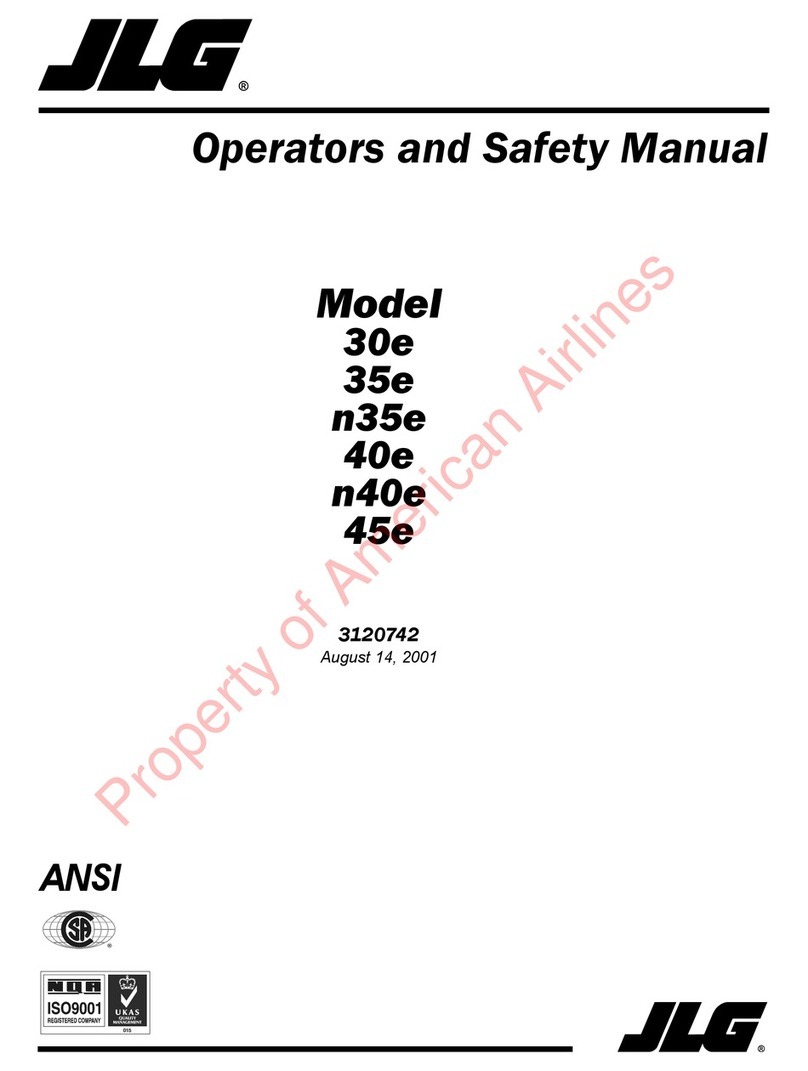
NEW PRODUCT WARRANTY
3121224 – Triple-L-Trailer – e
NEW PRODUCT WARRANTY
1. WARRANTY. JLG Industries, Inc. (“Manufacturer”)
warrants each new product made by it to be free
from defects in material or workmanship for twelve
months from the date of initial sale, lease, rental, or
other disposition of such product. Manufacturer fur-
ther warrants the structural elements of each new
product made by it, as defined in its then current
warranty policies and procedures, to be free from
defects in material or workmanship for one year
from the date of initial sale, lease, rental or other dis-
position of such product. Manufacturer agrees only
to repair or replace at its own expense, F.O.B. the
place or places of manufacturer, any part or parts of
the product found to be defective in material or
workmanship, provided Manufacturer is notified of
such defect or defects within the applicable warranty
period and given a reasonable time to correct the
defect. In no case shall any warranty extend to
defects in materials, components, or services fur-
nished by third parties or to the erection or installa-
tion of the product performed by third parties.
Defects caused by chemical action or the presence
of abrasive materials and defects arising following
the operation beyond rated capacity or the improper
use or application of any products shall not be con-
sidered defects within the scope of the above men-
tioned warranty. If any repairs or alterations are
made or any parts are replaced during the periods
covered by any warranty above mentioned by other
than an authorized Manufacturer’s Distributor in
accordance with authorized Manufacturer’s service
manuals or with other than parts, accessories, or
attachments authorized by Manufacturer for use in
its products, customer shall pay for such repairs or
parts without recourse against Manufacturer, and
Manufacturer shall be relieved of responsibility for
fulfillment of the above mentioned warranty with
respect to parts or components for all repairs, alter-
ations, or replacements so made. Manufacturer’s
obligations under this warranty shall at all times be
subject to its then current warranty policies and pro-
cedures. The above mentioned warranty shall not
apply to replacement or service parts made by and
sold by Manufacturer, with any obligation of the
Manufacturer to such parts governed solely by Man-
ufacturer’s then current warranty policies and proce-
dures.
2. DISCLAIMER AS TO CONSEQUENTIAL OR SPE-
CIAL DAMAGES. Under no circumstances shall
Manufacturer be liable for any consequential or spe-
cial damages which any person firm, corporation, or
other entity may suffer or claim to suffer or incur or
claim to incur as a result of any defect in the product
or in any correction or alteration thereof made or fur-
nished by Manufacturer or others. “Consequential”
or “special damages” as used herein includes but is
not limited to costs of transportation, lost sales, lost
orders, lost profits, lost income, increased overhead,
labor and material costs, and costs of manufacturing
variances and operational inefficiencies.
3. MAXIMUM LIABILITY. The maximum liability of
Manufacturer under the exclusive warranty set forth
herein shall be the amount paid to Manufacturer with
respect to the product to which such warranty
applies.
4. EXCLUSIVE AND ENTIRE WARRANTY. This war-
ranty constitutes Manufacturer’s entire warranty as
to the product and it is expressly agreed that the
remedies of customer and those claiming under
customer as stated in this warranty are exclusive.
Manufacturer does not assume (and has not autho-
rized any other person to assume on its behalf) any
other warranty or liability in connection with any
product covered by this warranty.
NOTE: Manufacturer expressly disclaims any and all other
warranties of any kind whatsoever as to the product
furnished hereunder, including but not limited to
express or implied warranties as to merchantibility,
fitness for particular purposes sold, description or
quality of the product furnished hereunder.
5. NOTICE OF OCCURRENCE. This warranty shall
be void if, upon the occurrence of any incident
involving any product made by Manufacturer and
resulting in any personal injury or property damage,
customer shall fail to notify Manufacturer within 48
hours of such occurrence or permit Manufacturer
and its representatives to have immediate access to
such product and all records of or within the control
of customer relating to the product and occur-
rence.
6. LIMITATION OF LIABILITY. The limitation of liability
provisions herein shall apply to any and all claims or
suits brought against Manufacturer including any
claim based upon negligence, breach of contract,
breach of warranty, strict liability, or any other legal
theories upon which liability may be asserted
against Manufacturer.
NOTE: Manufacturer may at any time amend the foregoing
form of warranty without prior notice.





























